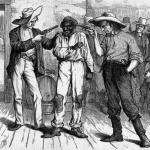Reconstruction, which began during the Civil War, had two main goals: to reincorporate the former Confederate states into the Union, and to transition the entire Southern population from slavery to freedom. President Andrew Johnson, a Southern Democrat, and the Republican-controlled Congress disagreed over what a “reconstructed” South should look like. Johnson instituted a plan for Reconstruction that put many ex-Confederates back into power in the Southern states, which had instituted Black Codes that severely restricted the rights of African Americans. By the end of 1865, Congress was so irritated with Johnson’s discriminatory policies that it seized control of Reconstruction, placed the South under military rule, and enacted new laws that empowered the federal government to implement equal rights. Johnson was impeached but avoided conviction and remained in office, although his power was greatly weakened.
Between 1866 and 1869, Congress passed civil rights laws and the 14th and 15th Amendments in an attempt to make America a more inclusive democracy. The 14th Amendment promised all American citizens equal protection under the law, and the 15th Amendment guaranteed black men the right to vote. These initiatives encountered widespread resistance from whites in both the South and the North.
By the 1870s public opinion began to turn against Republican policies in the South. Northerners, many of who never had a commitment to racial equality, grew tired of the endless turmoil of Southern politics. By 1876 the Democratic Party, strongly Southern and made up of many ex-Confederates, had a majority in the House of Representatives. Most of these officials wanted to eliminate the racial progress achieved during Reconstruction. Even the Supreme Court narrowed the scope of the 14th and 15th Amendments. In 1877 Pres. Rutherford B. Hayes withdrew the last of the federal troops from the South, and Reconstruction was officially over. But state and local policies known as Jim Crow Laws began, legalizing discrimination against African Americans in all facets of public life. Jim Crow Laws, upheld primarily in the South but also present in the North, were enforced for nearly a century.








